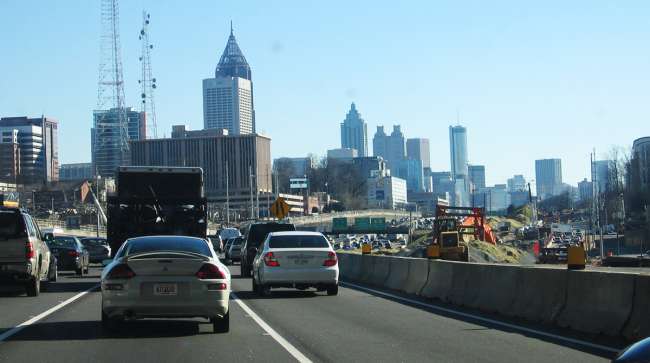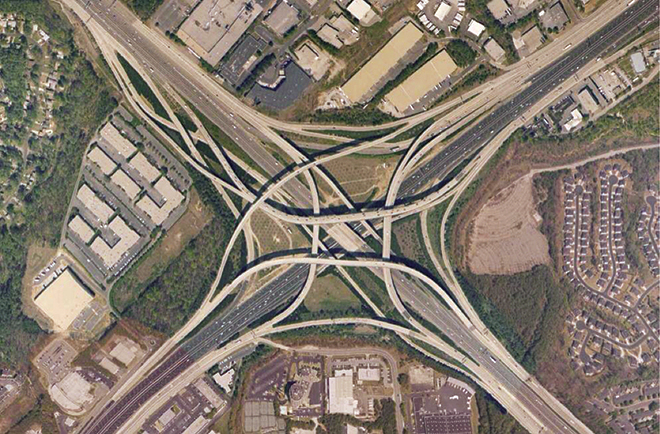Staff Reporter
Georgia DOT Proposes Trucks-Only Lanes Along I-75 Near Atlanta

Trucks moving through Atlanta, home to the most congested freight bottleneck in the nation, may find reprieve in the next decade with lanes dedicated solely to commercial motor vehicles.
The Georgia Department of Transportation has proposed two trucks-only lanes to run alongside a portion of Interstate 75.
The I-75 Commercial Vehicle Lanes project proposes two barrier-separated lanes along I-75 that will be dedicated to truck use. GDOT’s proposed trucks-only lanes will run northbound for about 40 miles from Macon to McDonough, an Atlanta suburb.
RELATED: Atlanta’s ‘Spaghetti Junction’ Tops ATRI’s Freight Bottlenecks List Again
The Federal Highway Administration identified the portion of I-75 outside Atlanta as a major route that carries at least 8,500 trucks per day. GDOT spokeswoman Natalie Dale said that 75% of the freight that comes into Georgia arrives in commercial vehicles.
“This area between Macon and metro Atlanta is really one of the most heavily trafficked freight corridors in the state,” Dale said. “We wanted to be innovative about how we were moving motorists and commercial vehicles in this corridor due to the nature of what was happening on this stretch of road.”
Atlanta is notorious for traffic congestion. The American Transportation Research Institute recently named the city’s “Spaghetti Junction,” where I-285 and I-85 North intersect, the most congested freight bottleneck in the United States. The intersection of I-285 North and I-75 in Atlanta ranked No. 4 on ATRI’s list.

Spaghetti Junction by NASA World Wind
GDOT anticipates that the two commercial vehicle lanes will reduce delays on I-75 by 40% in 2030.
“It’s definitely an important freight route through the state of Georgia,” said Georgia Motor Trucking Association President Edward Crowell. “There’s nothing not moving through Georgia.”
Crowell said increasing growth rates, both in population and the amount of freight flowing through the city, contribute to Atlanta’s congestion. The U.S. Census Bureau found that the population of Atlanta grew from 5,699,050 to 5,789,700 between 2015 and 2016. Crowell said that freight has increased as the city’s population has grown, and that the association’s freight projections indicate more volume.
Crowell also attributed increased freight to the Port of Savannah. In early December, three dredges began work in the Savannah River to increase the port’s channel depth to 47 feet from 42 feet. The Georgia Ports Authority announced Jan. 22 the port shattered its record for container traffic in a year, processing more than 4 million industry-standard 20-foot-equivalent units in 2017.
Because the general-purpose lanes on the interstate are often filled with commuters, Crowell said trucks-only lanes could be very valuable.
“[The lanes] could be extremely important. For Georgia, the challenge is to keep a free flow of freight. We have so much growth potential,” Crowell said. “What the state DOT is doing is trying to add capacity, but also look at alternatives. The truck-only lanes are a great alternative.”
GDOT is in the “pre-project initiation” phase of designing the lanes, identifying environmentally sensitive areas and studying passenger traffic patterns. The preliminary cost estimate for the project is $1.8 billion.
The proposed lanes will improve safety for truck operators and passenger car drivers, according to Dale. The roads outside of Atlanta contain many changing grades, which trucks need more time to adjust to than cars.
“By separating trucks and cars, you’re allowing trucks to harmonize how they move through those changing grades,” Dale said. “You’re creating a safer environment, you’re helping to move freight and giving it an innovative solution.”
Dale said the environmental assessments will determine what aspects of the plan can come to fruition. The environmental tests have been going on for about a year, and a pre-report of their results should be released within the next year. Construction is slated to begin in 2025.
“We are being innovative as a state by addressing problems that are specific to this corridor and addressing them in a way that is forward-thinking and will benefit not only commercial vehicles but also motorists like myself,” Dale said. “We feel that this is really going to be a great answer and a great answer for possibly many states who deal with problems like this.”




